So you’re in the market to buy a high quality kitchen knife. Boy, won’t your friends be impressed when you slice and dice and even make julienne fries. But as you start browsing, you’re hit with numbers and weights and…wait, is that a blacksmith?
Once you get serious about your cooking or grilling, you quickly learn that there are tons of options and variables to consider. From the type of knife to the steel used to how it’s made, every option can have an impact on everything from how a knife is used to how you should clean and store it. That’s not even getting into price. It’s very overwhelming to be honest, and the knife nerds out there love angrily arguing every detail.
To help you out a little bit, we decided to make this basic guide to help you better understand what quality kitchen knives are all about. Sure, you won’t be winning arguments on angryknifenerds.com, but it can help you get started on making an informed purchasing decision.
And maybe impress your friends.
Anatomy of a kitchen knife
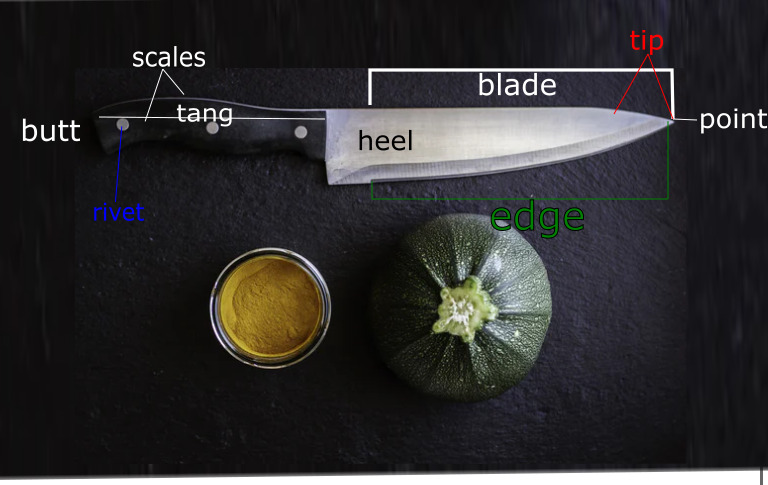
“Do you know how to use that thing?
Mask of Zorro
Yes! The pointy end goes into the other man!
Knives are simple right? You have your blade, you have your handle, you have something to cut.
Well, no.
Both the blade and handle can actually be broken down into several parts, and whether you’re going to sharpen, repair or just brag about your knife at the grill it helps to know what exactly the part you’re pointing at is called. And if you’re looking to pay good money to buy a quality kitchen knife, you should probably learn to talk the talk before you chop the chops (so to speak).
Blade
The blade is probably the most important part of the knife. A good blade will give you a smooth, precise cut and help minimize stress and food waste. A cheap or badly maintained blade will have you hacking away like a blind woodsman. The blade has several components to it:
Spine – The spine is the top of your knife blade. It’s blunt and thicker than the blade, which lets you put your hand or fingers on it without having to file an insurance claim. The spine allows you to put downward pressure on the knife with your finger(s) when cutting or chopping and helps with grip.
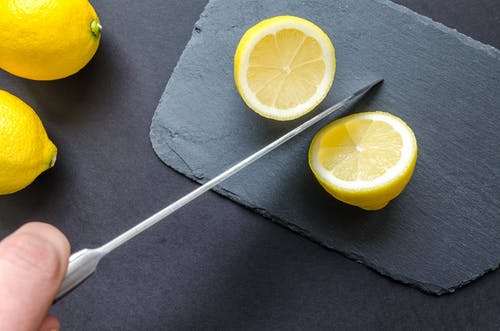
Heel – The heel is the back of the knife blade (like the heel of your foot), opposite the point. It’s the first cutting area after the bolster and is nice and wide, located at the thickest part of the knife spine. That makes it excellent for applying more force when cutting or chopping, especially harder things.
Tip – the tip is the front part of the knife edge. People often confuse it with the point. While it does contain the point, it’s a bigger area of the knife that has a small portion of edge to it, making it what you use when you have delicate or very detailed cutting to do. You don’t want to apply too much force to it.
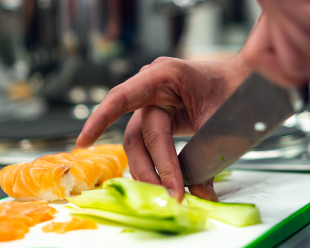
Bolster
The bolster is the raised, thick part of the knife that runs between the blade and the handle. It can help balance and stabilize the knife, as the handle tends to be lighter than the blade. Typically, bolsters are found on forged knives but can also be added to laser cut or stamped knives.
Bolsters often have finger guards, which can protect your hands from slipping forward onto the knife edge.
Whether you like a bolster on your knife, hate them or don’t care is usually a matter of preference (and boy do chefs and knife guys get worked up over it).
As a rule of thumb there are:
Full bolster knives – this is where the bolster can extend all the way to the bottom of the blade.
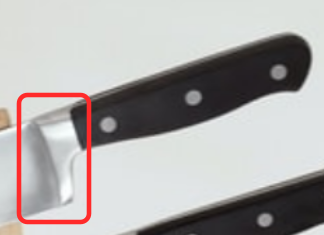
| Pros | Cons |
|---|---|
| Slight added finger protection | Can make knife harder to sharpen properly |
| Some people like the grip position and handling | May interfere with using the full edge of the knife |
No Bolster – This is where there is no bolster at all on the knife.
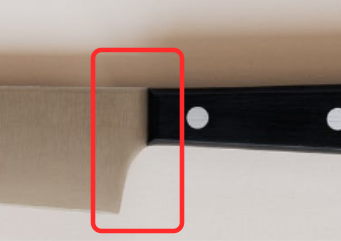
| Pros | Cons |
|---|---|
| Easier to sharpen and maintain knife | Some people find them less safe and don’t like the idea of their hand being able to easily slip onto the blade |
| Some people like the way they handle | Poorly made knives can have even worse balance issues |
Semi-bolster or Half-bolster knives: If you can’t decide, or have no strong preference, there are also semi-bolster or half-bolster knives. They are the best (or worst, depending on how you look at things) of both worlds.
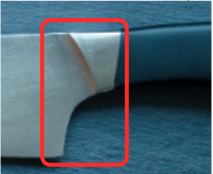
| Pros | Cons |
|---|---|
| Easier to sharpen than full-bolster | Not as much protection as a full bolster, slightly more than no bolster (depending on how its made) |
| Enables more/full use of the blade edge |
Why does my knife blade have little indents or dimples on the side?
Some kitchen knives have little dimples on the edge, also referred to as divots, indents, scallops and kullens (or Kullenschliffs if you like German). Among those who like to talk knives, these knives are called Granton edge knives. They’re called that because they were originally invented in England by the Granton Knife company. Simple.
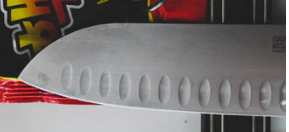
The scalloped edge is designed to create little air pockets between the knife and what it’s cutting. The idea is to reduce friction when slicing and prevent food from sticking to the knife, making things easier for you while giving a cleaner cut.
Not only do they look cool, they’re functional too, so it’s no surprise they are popular with home chefs and cooking enthusiasts.
What kinds of knives typically have Scalloped Edges?
You’ll find scalloped edges on many types of kitchen knives, particularly those that are used for lots of slicing and carving. So you might see them on Santoku knives, carving knives, pairing knives and many higher end chefs knives.
Any downsides?
Granton edge knives are more or less like any other knife, really. They are generally a little more expensive and are made from thicker steel, so they can be a little bit heavier.
Handle
The handle is also made up of a few parts you should get to know.
Tang: The tang is actually the narrower, unsharpened part of the knife blade that extends into the handle, sometimes all the way to the end (called a full tang). Essentially, it’s the backbone of your knife and allows you to exert force on the knife through the handle without something breaking or falling off.
Which is, you know, nice.
Full tang knife: where the unsharpened metal of the knife blade extends back all the down the length of the handle. Sometimes you can see it at the butt of the knife, sometimes not (hidden tang). Generally, the whole knife is made of one piece of unbroken steel sandwiched between grips.
| Pros | Cons |
|---|---|
| Strengthens the knife | Takes more work for the knifemaker to offset the extra weight, meaning these knives can be heavier and/or more expensive |
| Can contribute to proper balance and handling- let’s you put more leverage on the knife when chopping, cutting, etc. |
Partial Tang knife: here a more narrow unsharpened section of the blade extends only partially into the handle itself, rather than all the way to the end of the knife. They can be a stub of metal, half-way or even three-quarters, depending on how far they extend.
| Pros | Cons |
|---|---|
| Usually cheaper to make, buy | Balance can sometimes be an issue if not corrected properly by the maker, which can drive up the price |
| Lighter weight | Usually shouldn’t apply as much force to it as a full tang |
Rivets – These are the metal pins that hold the knife handle together. Some knives don’t have them and instead have a molded handle.
Scales – The scales are the grips that are attached to the handle, sandwiching the tang. They’re what you hold on to. They can be made of synthetic or natural materials.
Some common scale materials for kitchen knives include:
Wood
| Pros | Cons |
|---|---|
| Aesthetically pleasing and natural | Prone to warping, cracking |
| Lots of types of woods to choose from | Not as water resistant as other materials |
| Good impact resistance | Cheap wood splinters |
| Engravable | |
| Low thermal conductivity – doesn’t heat or get cold as easily as metal |
Bone
| Pros | Cons |
|---|---|
| Rustic aesthetic, pleasing and natural | Harder to clean |
| Can be dyed to change color | Less impact resistant than other options |
| Lots of different natural and carved shapes | Porous (bacteria can settle in) |
| Engravable | Can get slippery |
| Low thermal conductivity – doesn’t heat or get cold as easily as metal |
Aluminum
| Pros | Cons |
|---|---|
| Lightweight | Easily scratches |
| Lots of color options | High thermal conductivity – gets hot/cold quickly |
| Rust resistant | Can get a little slippery |
| Durable | |
| Easy to clean |
Fiberglass and carbon fiber
| Pros | Cons |
|---|---|
| Super Lightweight | Can be more brittle |
| Heat resistant | Can be more expensive |
| No rust | Prone to cracking (carbon fiber) |
| Easy to clean | Should be handwashed |
Plastic (Polypropylene and ABS)
| Pros | Cons |
|---|---|
| Colorful possibilities | Some people don’t like the look and feel of plastic |
| Inexpensive | Prone to scratches |
| Fairly durable, no rust | |
| Easily washable |
Steel Yourself: The Basics of Knife Steel
So now you know a little bit about knife anatomy. and construction.
But what the knife is made of is often almost as important as how it’s made. The steel used in the blade can determine how it cuts as well as how resistant it is to corrosion, chipping, dulling.
Unfortunately for you, the buyer, manufacturers tend to use a mindboggling assortment of steels (some even proprietary) to achieve different characteristics and marketing talking points for their products. Now, obviously, we can’t delve deeply into each and every variety of steel out there, but we can give you a general idea.
When it comes to kitchen and chefs knives, you’ll most often come across various stainless steel and carbon steel knives.
Stainless Steel Knives
You know stainless steel, right?
A corrosion and rust resistant form of steel (hence the stainless), it contains a minimum of 10% chromium and is a relatively affordable, popular and low-maintenance option for knives.
In fact stainless steel has a lot of properties that make it attractive and the most highly recommended steel for most home-chefs, pit-masters and other cooking enthusiasts.
General properties of stainless steel knives:
- Rust resistance
- Softer than carbon steel (generally)
- Corrosion resistant
- Relatively easy to sharpen
- Low maintenance
Just a few common Stainless Steels you might find mentioned for cutlery:
420 J Series Steel (Hardness – about 50 HRC)
Generally used in more inexpensive knives, this steel, while still rust resistant, is generally softer, easier to sharpen but doesn’t hold an edge as long as harder, more premium steels.
440 Series Steel
440A (Hardness 55-58 HRC)- Better able to be hardened than 420 steel, 440A offers a good balance of hardness, durability, edge retention and corrosion resistance.
440C (Hardness 58-60 HRC) – With added chromium and carbon, 440C is harder and takes and maintains a sharper edge than 440A and is more commonly used. It is, however, slightly less corrosion resistant.
4116 (X50CrMoV15) (Hardness 56-57 HRC) – Originating in Germany, 4116 steel is relatively soft and relatively inexpensive compared to other premium steels, but offers decent edge retention and, with a good balance of carbon and chromium, good corrosion resistance.
AUS Series (AUS-8/ AUS-10) (Hardness AUS 8- 57-59 HRC, AUS-10 59-60 HRC)- Somewhat similar to the 440 series, the Japenese AUS Series steel have added vanadium for added hardness and edge-retention. Generally speaking, they offer a good balance between edge retention and ease of maintenance/sharpening.
Very broadly speaking, AUS-8 is most similar to 440A/B, but harder, whereas AUS-10 is similar to 440C although harder and with less chromium (and less stain resistance).
154CM (ATS-34) (Hardness 59+ HRC) – Fairly widely used with high end performance kitchen knives, 154CM takes and holds a sharp edge really well, better than 440s, but can be slightly less stain resistant. Compared to some harder, premium steels, it dulls faster but can be easier and less expensive to sharpen.
VG-Series (VG-10/VG-Max) (Hardness 60-62+) – Similar to 154CM but has a higher amount of added vanadium. A little bit tougher, and a little more corrosion resistant.
CPM S30V (Hardness 58-60+)- S30V is a very hard steel, with a typically high chromium content and added molybdenum/vanadium. Typically has high corrosion resistance, is relatively durable and holds a sharp edge very well. However, although it may not dull as often it is known for being difficult to sharpen.
So, wait. What is powder steel?
Put very simply, powdered steel is a type of steel formed from various metals that are first liquified together, pushed through a nozzle, and then rapid cooled. The result is an powder with the same amount of each element mixed evenly throughout, unlike normal forging. The powder can then be pressed into a single piece of steel.
Aside from being a pretty cool way to make a knife, powder steels have a number of advantages for knife use.
Pros: They can be harder than traditional stainless steels, while still having decent toughness to resist chipping and cracking, can have good corrosion resistance and can be easier to sharpen.
Cons: They can be expensive to buy, may not be as hard or hold an edge as well as some high end high carbon steel knives.
In the end, powder steel offers a great, modern bridge between traditional easy to maintain stainless steel knives and their harder, very sharpenable, but higher-maintenance high carbon counterparts.
Some types of powder steel you might come across:
SG2 (stainless) – Very popular powder stainless steel used in knives. High corrosion resistance, good hardness and toughness.
ZDP-189 (stainless) – High carbon/chromium blend. Relatively rarer, harder to process and expensive.
HAP-40 (non-stainless) – Made by Hitachi, it has an unusually wide range of elements (carbon, chromium, tungsten, molybdenum, vanadium, cobalt) that give it an excellent balance of hardness and toughness.
Note: Like other steels, If there is more than 10.5% chromium present, you can have powder stainless steel.
Carbon Steel Knives
Adding carbon to increase hardness is an old, old method. When properly heat-treated they are hard, sharp and easy to sharpen. These knives have had a romanticism attached to them that has captured the hearts (and hands) of chefs the world over. Usually found on more high end or exotic kitchen knives, these knives require more maintenance and care since they can rust and chip, although they can develop a cool patina over time.
General properties of high carbon steel knives:
- Can get really sharp
- Stays sharper longer than stainless
- Easier to sharpen
- Usually harder than stainless steel
- More brittle, less flexible – may chip easier
- Requires more care and maintenance- may rust/stain
- Develops a patina with use and time
There are lots of different types of carbon steels you can find in various knives. Some notable high carbon steels you might find mentioned:
10-series (1095 steel in particular) (Hardness – 56-58, but can vary) – You’ll find 10-series a lot in the cutlery world. Generally speaking, as the series goes on the higher the number, the higher the carbon amount (1095 has more carbon in it than 1050, for example). That means as the number gets higher they tend to become harder, but more brittle, and have better more edge retention. 1095 steel is most often used for kitchen knives, balancing affordability, edge retention, hardness and ease of maintenance. They are prone to rust and staining, however.
White paper steel (Shirogami #1-3) (Hardness 60-65+) – A very fine-grain carbon steel, white steel has a reputation for being able to be sharpened easily and ability to hold it’s razor sharpness. Graded as #1-3 in descending amounts of carbon, #1 is the hardest and holds its edge the longest, while #3 resists chipping and is more durable. Very prone to rusting and staining.
Blue Paper Steel (Aogami #1, #2, Super) (60-70+ HRC)- Blue Paper steel is White Paper Steel mixed with chromium and tungsten to increase durability and chip-resistance. Blue #1 generally has more carbon than #2, making it harder and more able to hold an edge, at the cost of increased brittleness. Blue Paper Super has added vanadium to increase strength and wear-resistance beyond the other two. Like White Steel, it is quite prone to rusting and staining.
Forged Vs Stamped Knives
If you’re in the market for a kitchen knife, and you do your research, you’ll notice that some of the knives you’ll look at are described as “forged” and some are described as “stamped.” Now, what does that mean to you, the guy with the brisket that’s waiting.
Forged knives
A forged knife is one that is taking a single bar of steel and pounding it into shape with a hammer or die press. If you’ve ever watched a blacksmith on tv, you’ve probably seen something similar. Makers take their pieces of steel and heat them in a furnace until they are nice and (very) hot, pull it out and pound them repeatedly into a knife-shape.
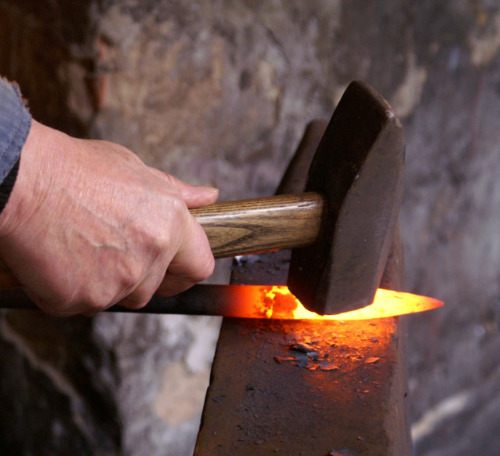
On a molecular level, this process tends to realign the molecules in the metal. As a result, the steel tends to be stronger, more durable and therefore less likely to shatter. Forged knives are also thought to keep their edge longer. That’s why forged steel was used for swords back in the days of yore, and why it also may well serve your trusty roast slicer today.
Usually (but not always), you’ll find a bolster on a forged knife, although bolsters can be added to laser cut and stamped knives, although it’s not as common.
Stamped Knives
A stamped knife, on the other hand, is when the maker takes a sheet of steel and stamps or cuts out a knife shape from it. Afterwards, the knives are heat-treated, hardened and finished as needed.
Stamping allows a maker to quickly and efficiently manufacture knives. Depending on the pattern and quality and type of steel used they can be relatively strong and durable, as well. Stamped knives also tend to be a little thinner and lighter in the hand than forged knives, typically, which some people like.
Ok, but how does this affect me and my cooking?
Price
Well, for one thing forged knives tend to be more expensive than their stamped alternatives, due to the extra labor involved. So if you’re on a budget, that might be an important factor.
Handling
Stamped knives tend to be more lightweight and flexible, being typically thinner. Some people like the feel of a lightweight knife, saying it feels easier to use in their hand.
Other people prefer a weightier, well-balanced forged knife in the kitchen or at the grill, feeling it gives them more cutting power and feels sturdier.
This one is up to you.
Flexibility
Forged knives tend to be harder and less flexible than stamped. This is great for edge retention and sharpening, but can make things more difficult when you need a knife that can bend and twist, such as when filleting.
Quality
Used to be that people just assumed that forged knives were of better quality than stamped. Today, the lines have blurred with quite a few high quality stamped knives on the market and tons of cheap forged knives being poorly made and sold to unsuspecting users. So do your homework, make sure to hold the knife and let the buyer beware.
Head to head
When it comes to knives there’s no real hard and fast rules since so much depends on the maker and the knife itself. But in very broad terms, this chart might help compare the two processes.
| Forged Knife | Stamped Knife | |
|---|---|---|
| Price | More Expensive | More affordable |
| Weight | Heavier | Lighter |
| Flexibility | Less Flexible | More Flexible |
| Hardness | Harder | Softer |
| Tang | Full or Semi | Varies |
| Thickness | Thicker | Thinner |
| Sharpening | Easier, although bolster (if present) can sometimes cause issues | Flexibility sometimes makes sharpening more difficult |
Conclusion
Now that you’re a bit more informed about knives, their construction, and their terminology you should be a bit more prepared when it comes time to choose your very own slice-and-dicer. Keep in mind, the information in this guide is very general, each make and brand can still differ significantly and surprise you.
But, hey, it’s a start and you might be able to impress someone at the grill with something you learned here.

Steph Acevado Having previously worked as a line chef for almost 5 years, Steph is our go-to expert for all things food and meal prep related and is a self-described knife nerd. When she’s not helping people learn to prepare exquisite dinners at home, she’s probably serving up some hot pockets for her twin boys or jogging with her pup Moose around her house in upstate New York.
